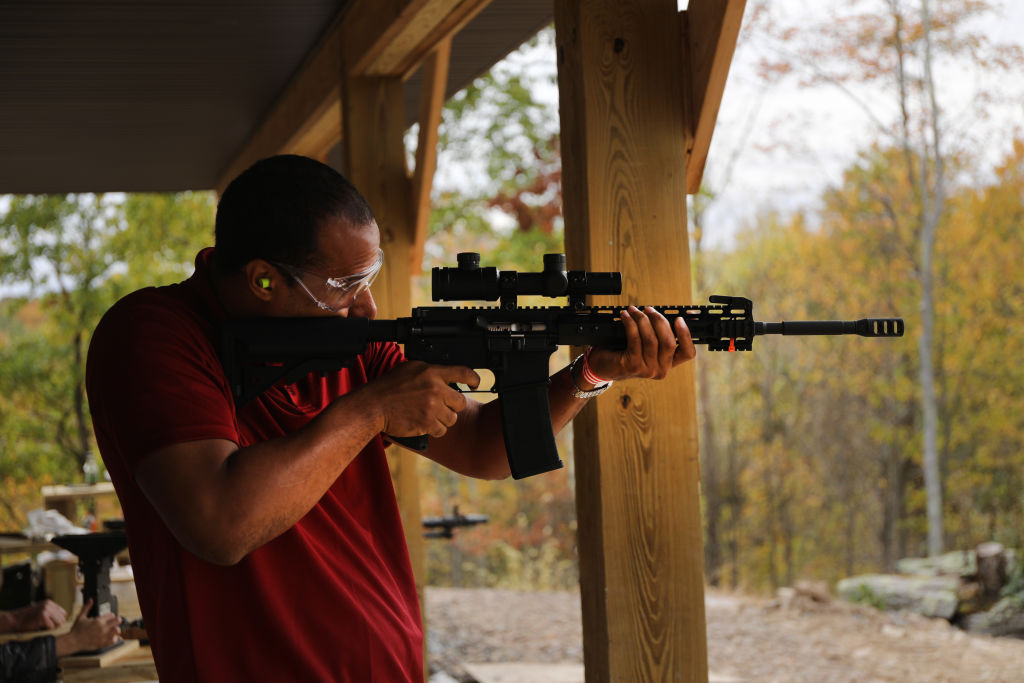When it comes to the AR-15, the Washington Post keeps getting it wrong. A piece headlined “The Blast Effect” makes various claims about the rounds fired by AR-type rifles, some of which are untrue, the rest of which are common to almost all centerfire rifles. The Washington Post’s claim that the AR-type rifle is “uniquely destructive” is categorically false. The journalistically responsible thing to do would be to retract these claims, but the Post is not engaged in journalism—it is engaged in culture-war propaganda.
I have been annotating some of the errors in the Post’s hysterical and error-ridden series on firearms and firearm-enabled violence, and today I will look at the claim that AR-pattern rifles are especially dangerous because the 5.56mm bullet moves so fast:
“What makes the weapon so deadly is the speed of that bullet,” the Post claims.
(If you will forgive a little prologue: I will set aside, for the moment, the fact that there are lots of firearms that fire the 5.56mm NATO round and its fraternal twin, the .223 Remington. The bullet does not go extra fast when fired from an AR-style rifle; in fact, it typically will be going a bit slower than when fired from a traditional hunting rifle, because AR-style rifles usually, though not always, are outfitted with shorter barrels. The math isn’t exactly linear and there is a point of diminishing returns, but, generally speaking, a bullet will achieve a higher velocity coming out of a longer barrel, because the longer barrel allows more of the propellant to be burned before the projectile exits the muzzle. That is one of the reasons rifles are generally, though not in every instance, more powerful than handguns. You can see this phenomenon illustrated with cartridges that are commonly fired from both handguns and from rifles, e.g., the .357 Magnum, which will add about 40 percent to its velocity when fired out of a rifle compared with firing it out of a handgun. The 5.56mm is often fired from handguns, notably AR-style handguns, which are pretty common; the AR-style weapon used in the Nashville massacre was, technically, a handgun chambered in the .300 AAC cartridge. From the photos, it appears it was a “pistol” fitted with one of those phony “arm braces” that are, in practice, shoulder stocks, meaning that it was a de facto rifle even if it was a de jure handgun. The other weapons were a 9mm handgun and a pistol-caliber “carbine,” meaning a small rifle, in this case a KelTec rifle chambered either for the 9mm or the .40 S&W—I don’t have a definitive answer for which of those it was at this time.)
The Washington Post’s claim about velocity per se is, of course, preposterous, as anybody who hunts—or who knows a little bit of physics—can tell you. And if you don’t trust people who know a little bit of physics, try people who know a lot of physics: The Post’s claims run directly contrary to much of the specialist professional medical literature on the subject, particularly the work of the late Dr. Martin Fackler, president of the International Wound Ballistics Association, who provides an accessible overview of the issues in the Annals of Emergency Medicine, among other writings. More about that in a bit.
The physical metric that most matters for tissue damage from a bullet is not velocity alone but kinetic energy—which is to say, speed and mass. (To be precise, kinetic energy varies proportionately with mass and with the square of velocity.) That’s why a Nerf ball going 110 feet per second out of the Nerf Hyper blaster bounces off your chest but a Mack truck going the same 110 feet per second—75 mph—does not bounce off your chest. From time to time, you get hit by a very small object moving incredibly fast, and you won’t even feel it, because it is infinitesimally small. This isn’t an outside-the-box argument or an obscure technicality: The experts the Post consults themselves mostly identify energy as the critical issue, though the Post does not, insisting that it is a matter of bullet velocity. That is good propaganda but bad physics: The bullets typically fired by AR-type rifles do indeed move very quickly, but, because they are relatively small compared to most rifle rounds, they do not carry a great deal of kinetic energy compared to bullets fired by most common hunting rifles or target-shooting rifle. For comparison, a 5.56mm round coming out of an AR-type rifle is a little less than half as powerful as a round coming out of your granddad’s .30-06 deer rifle.
Which makes sense: The effect of kinetic energy rather than velocity alone is why you don’t hunt elephants with a 5.56mm semiautomatic rifle but with something that fires a much slower-moving projectile, such as a .458 Winchester Magnum. That big-game round isn’t nearly as speedy as the 5.56mm (about 2,100 feet per second for the .458 compared to 3,000 to 3,500 fps for the 5.56mm), but it hits with almost five times as much kinetic energy. Conversely, there are rounds that go a lot faster than the 5.56mm that are a lot less powerful—for example, the .17 Remington (4,000+ fps) or the .204 Ruger (4,200 fps), which are used for hunting squirrels. The Post’s insistence on the role of velocity is scientifically illiterate, but if the Post were to focus on the more relevant issue of kinetic energy, it would be cornered into admitting what anybody with any real knowledge of these issues could tell you: The AR-type firearm is, in most variations, a modestly powered rifle. In some states, you cannot even hunt deer with a 5.56mm rifle, because it is considered insufficiently powerful for ethical hunting. Of course, you don’t need a super-powerful rifle to kill human beings, whose bodies are not as sturdy as those of bison or elk, but the Post’s writers and likeminded activists have a very strong political commitment to the fiction that the AR is a special, especially dangerous firearm. It is a win-by-inches strategy based on a lie.
You don’t need a lot of physics to understand the factors at work: Drop a piece of gravel on your foot, and then drop a bowling ball on your foot—they’ll be going the same speed when they land, but one of them is going to hurt a lot more. This is not some kind of arcane ballistic knowledge. These are measurable metrics. There are charts. You can look them up. There is a whole body of military and medical research on rifle wounds, too.
There are other equally important factors when it comes to gunshot wounds, principal among them projectile design. A North American bison is a lot bigger and tougher than a human being, but a great many of them have been killed over the years with bows and arrows, even though arrows do not carry as much kinetic energy as the least-powerful bullets or go as fast as the slowest bullets.
As Fackler notes:
Basic physics verifies that a projectile’s potential to disrupt tissue is determined by both its mass and its velocity. Wounding potential is also determined to a great extent by a bullet’s physical characteristics. Projectile construction and shape determine a bullet’s tendency to deform, fragment, or change its orientation (by becoming unstable and “yawing,” or turning sideways, relative to the line of flight). Such behavior in tissue greatly affects tissue disruption.
You will not be surprised that the Washington Post completely ignores that consideration when writing about the “uniquely destructive power of the AR-15,” which is not uniquely destructive. Or, to be more precise, it ignores that consideration when it suits the paper’s rhetorical purposes: For example, an illustration of a notional 9mm wound shows the bullet simply passing through the body in a straight line with no expansion or fragmentation, even though handgun rounds intended for purposes other than target shooting are typically designed to do just that. (If you’ve wondered what a “hollow-point” is, that’s what’s meant—a bullet designed to expand in tissue, which serves the dual purpose of maximizing tissue damage and reducing overpenetration, an important consideration for self-defense shootings in the home or in public.) If you are interested in what a 9mm round actually does after impact, you can go to YouTube and watch any number of videos of 9mm handguns being fired into ballistic gel. There will be a variety of outcomes, because there is a variety of bullet designs.
Fackler and his contemporaries had access to a very large sample of wounds inflicted by actual military rifles: the casualties of the Vietnam War. Fackler addressed the issue of velocity specifically and concluded that many of his contemporaries who were making more or less the same claims the Washington Post makes today were peddling pseudoscience—with potentially terrible consequences for trauma surgeons. If you will forgive a long quotation:
In 1974, a Swedish wound-ballistics researcher claimed that the tissues surrounding wounds caused by “high-velocity” projectiles were “subjected to the formation of the temporary cavity [which was] 30 times the diameter of the projectile” and that these tissues “will not survive.” Implicit in this claim was that in the treatment of any wound caused by a “high-velocity” projectile the surgeon must excise a cylinder of tissue at least 30 times the diameter of that projectile: To treat a wound caused by a 30-caliber bullet (such at that fired by the AK-47 “assault rifle”), a surgeon would have to carve out a cylinder of tissue at least 9 inches in diameter. This procedure equates to performing amputation for practically any wound of the arm or leg.
Others have also claimed that assault weapon bullets cause massive injuries, including traumatic amputation. In addition, many fallacies regarding bullet effects were presented in the 1975 edition of The NATO Handbook: Emergency War Surgery, including a description of the temporary cavity for “high-velocity missiles” as “30 to 40 times the size of the missile.” Although the Swedish findings were subsequently disproved and a new objective and scientific chapter on missile-caused wounds was written for the 1988 edition of The NATO Handbook, widespread misinformation persists.
Delegates to the Tri-Service War Surgery conferences of 1970 and 1971 reported no unusual problems associated with “high-velocity” bullet wounds in Vietnam. There were no reports of rifle bullet wounds causing traumatic amputation of an extremity. No one recommended removal of an amount of tissue even remotely approaching a 9-inch-diameter cylinder from the wound caused by an AK-47 or any other rifle.
Other reports on rifle bullet wounds from Vietnam also gave a very different impression: “Uncomplicated perforating soft-tissue wounds were the most common bullet wounds of the extremities. They showed small entry and exit wounds and a clean soft-tissue track with little no devitalization of tissue. Such wounds usually healed if left alone.”
Fackler was indeed so vexed by these misrepresentations that he wrote of the “idolatry of velocity.” In addition to the Fackler article mentioned above, I also recommend his report (“What’s Wrong with the Wound Ballistics Literature,” 1987) from the now-defunct Division of Military Trauma Research at the Letterman Army Institute of Research. If anybody at the Washington Post is interested, there was a useful contemporary writeup about the institute’s research into the velocity issue right there in the Washington Post.
If the editors of the Washington Post really believe that speed is what makes a bullet lethal then, by all means, I invite them to take one of those high-velocity squirrel guns mentioned above—or a 5.56mm AR-style rifle, for that matter—up to Alaska to hunt some coastal grizzlies. I’d recommend doing some thorough estate planning beforehand.
All the Post has actually established is that a modestly powerful rifle is typically more powerful than a modestly powerful handgun—authoritatively disposing of a matter that has never been, as far as I can tell, in dispute. In a truly tawdry exercise in emotional manipulation, the Post writes luridly of the wounds suffered by 15-year-old Peter Wang in the Parkland massacre. His wounds were, indeed, horrifying: He was shot 13 times, including four shots to the head at point-blank range. We need not be callous to the death of that child to understand that being shot four times in the head with practically any firearm would be lethal in almost all cases, and that his wounds would have been even more severe if he had been shot with almost any other kind of rifle, in particularly one of the ordinary hunting rifles that gun-control advocates insist they have no interest in prohibiting.
The Post further claims: “The AR-15 fires bullets at such a high velocity—often in a barrage of 30 or even 100 in rapid succession—that it can eviscerate multiple people in seconds.” Setting aside the very strange construction of that sentence (who can eviscerate?) the Post wisely has not put a number in front of “seconds,” but I would be very curious to know how many seconds the authors have in mind. Even with a 100-round magazine, it takes a while to fire 100 rounds from an AR—and it takes longer if you are trying to hit something in particular. That being said, the sentence above is entirely incoherent: The velocity of the bullet has nothing at all to do with the rate of fire of the weapon—if those 5.56mm rounds were moving at half the speed they do, that would have no effect on the ability of a shooter to “eviscerate” x number of people in y seconds. These are entirely separate issues. The sentence is on its face nonsensical, a fact that would be clear to any editor who was both competent and interested, but what the Washington Post is here engaged in is not journalism.
Why do these details matter?
They matter because facts matter, of course: We are not going to build intelligent policy on a basis of mistakes, misrepresentations, and hysteria. When the Post and others argue that certain kinds of firearms or ammunition should be restricted or prohibited because of particular physical characteristics of those firearms or ammunition, then we should ask whether the claims about these physical characteristics are, in fact, true.
It simply is not the case that the 5.56mm rounds typically fired from an AR-type rifle do more damage to the human body than do common rounds fired from common rifles, especially hunting rifles. (It would be a neat trick to design a bullet that is useful for killing a 1,000-pound bull elk that is not dangerous to people.) As I have argued at length here and elsewhere, the focus on particular exotic-looking or aesthetically charged firearms is pure culture war, having very little to do with the realities of American murder. And what are those realities? One in 5 U.S. homicides involves no firearm at all, and of the ones that do involve a firearm, AR-type rifles are used in so few instances that the FBI does not even bother to break them out in the crime data, though we do know that all rifles combined make up about 2.6 percent of the weapons used in homicides. U.S. murder victims are more than four times as likely to be stabbed to death as to be shot to death with a rifle of any kind, more likely to be punched or kicked to death, more likely to be beaten to death with a blunt object, etc. (You can consult the relevant FBI data here.)
On the other hand, we tend to ignore very strong correlations that are politically and culturally inconvenient for Democratic politicians and their media allies: For example, the vast majority of murders are committed by people with prior criminal records, usually extensive ones. In Chicago, for example, the typical murderer has 12 prior arrests before being brought in on a homicide charge. In New York, prior offenders account for nearly 90 percent of homicides, and a quarter of those who commit murders do so while on parole or probation for a prior offense. And yet in many jurisdictions, the great majority of gun-charge cases are dismissed without trial—60 percent of gun cases are dismissed in Philadelphia, up from 30 percent as recently as 2016. All this bloodshed doesn’t come out of nowhere.
I have pointed out many of the Post’s errors, both here and in a letter to the newspaper. For example, the Post claims: “The deadliest mass killing at a K-12 school in U.S. history focused attention like never before on the destructive power of the AR-15.” That is not only untrue but impossible, given that the deadliest mass killing at a K-12 school in U.S. history happened in 1927, decades before there was an AR-15 to focus on. The Post presumably meant Newtown, which was a shooting, as opposed to the 1927 massacre in Bath, Michigan, which was a bombing. As of this writing, the Post has declined to correct these errors. You can get a pretty persuasive story if you exclude the facts and events that do not harmonize easily with your prejudices.
But that isn’t journalism.
- From earlier this week: Under the Black Flag
- A Guide to Guns







Please note that we at The Dispatch hold ourselves, our work, and our commenters to a higher standard than other places on the internet. We welcome comments that foster genuine debate or discussion—including comments critical of us or our work—but responses that include ad hominem attacks on fellow Dispatch members or are intended to stoke fear and anger may be moderated.
With your membership, you only have the ability to comment on The Morning Dispatch articles. Consider upgrading to join the conversation everywhere.